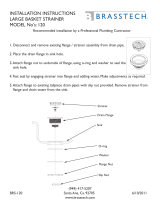
8
OPERATING THE DISPOSEROPERATING THE DISPOSER
OPERATING THE DISPOSEROPERATING THE DISPOSER
OPERATING THE DISPOSER
1. Make sure there are no foreign objects in the
disposer grind chamber.
2. Push the start button on the control switch. (The
disposer will run and water will flow into the
disposer.)
3. Feed food waste into the disposer in a steady,
continuous flow.
4. When all food waste is flushed away, push the stop
button on the control switch.
NOTE:NOTE:
NOTE:NOTE:
NOTE: The Manual Reversing Switch has a center OFF
and a left
or
right ON position. The disposer will run
in the direction the switch is pushed. DO NOT restart
the disposer until the shredder has come to a stop.
GRINDING TIPSGRINDING TIPS
GRINDING TIPSGRINDING TIPS
GRINDING TIPS
••
••
• Ensure that a steady stream of cold water runs into
the disposer while it is operating. (See Table 2 on
page 6 for the recommended cold water flow.)
••
••
• Do not overload the disposer or turn it off with food
waste inside the grind chamber. (Run the disposer
and water for three minutes after the final load to
flush away all food waste.)
Personal Injury
• Food waste disposers are designed to grind and dis-
pose of normal food waste. Inserting materials or items
other than food waste into the disposer could cause
personal injury and/or disposer damage.
• To reduce the risk of injury from materials that may be
expelled from the disposer grind chamber, ensure that
the disposer baffle is properly installed.
• To prevent the ejection of food waste and to keep for-
eign material out of the grind chamber, replace the
splash baffle when it becomes worn.
• Do not put any of the following items into the disposer:
clam or oyster shells, drain cleaner, glass, china, plas-
tic, plastic wrap, large bones, metal objects, explo-
sive materials, or extremely hot water or grease/oil.
• Turn the power off before attempting to clear a jam,
removing an object, or pressing the reset button.
• Do not insert your fingers into the disposer. Use a
long-handled tongs or a pliers to remove objects from
the disposer.
• Loosen any jams with the dejamming bar.
• Be certain that all persons who will operate the dis-
poser read the safety and operating instructions prior
to operating the disposer.
• To prevent accidents, ensure that the disposer is
turned off before you leave the area.
OPERATING INSTRUCTIONSOPERATING INSTRUCTIONS
OPERATING INSTRUCTIONSOPERATING INSTRUCTIONS
OPERATING INSTRUCTIONS
Fire Hazard
To minimize the possibility of fire, do not store flammable
items near the disposer. Do not use or store gasoline or
other flammable liquids near of the disposer.
Electric Shock
• Disconnect the electrical supply before servicing the
disposer.
• Ensure that the disposer and controls are properly
grounded.




















